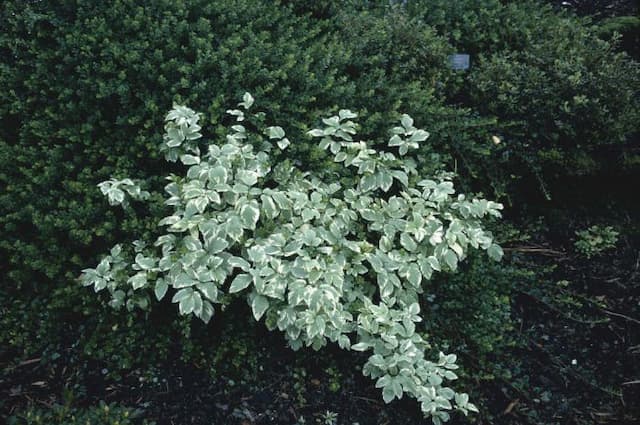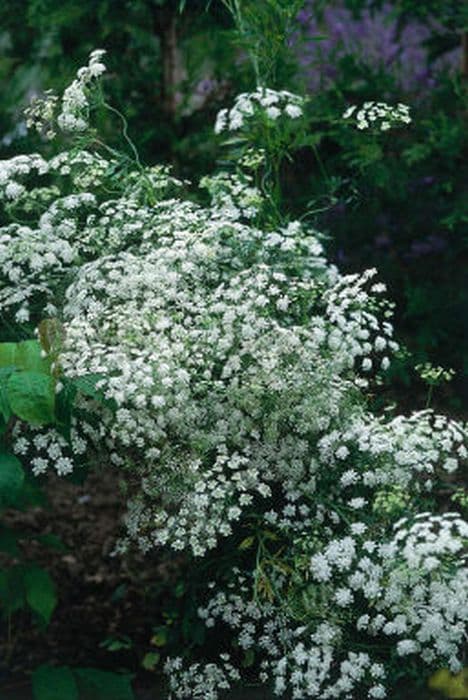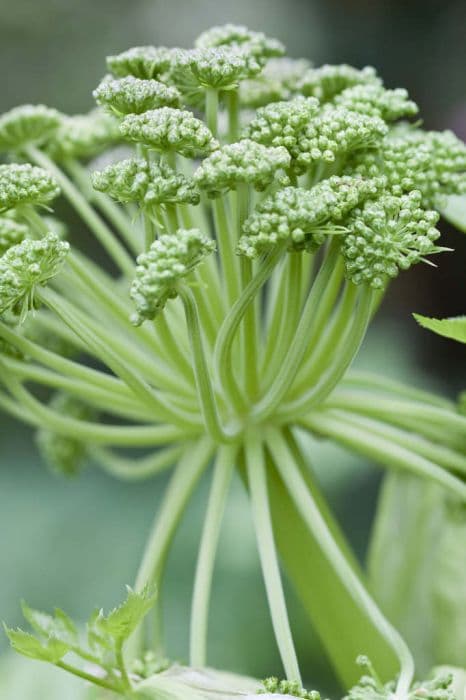Masterwort Astrantia 'Buckland'

ABOUT
Astrantia 'Buckland' is a perennial plant with a captivating charm, primarily due to its distinctive floral display. This particular variety is noted for its pincushion-like flowerheads, which are composed of a multitude of tiny, star-shaped flowers gathered tightly together. These flowers present themselves in a subtle shade of pink and are encircled by a halo of bracts that can be slightly larger and often display a paler pink or greenish hue. The overall effect is a delicate and intricate bloom that is both whimsical and appealing to the eye. The foliage of Astrantia 'Buckland' is equally attractive, consisting of deeply lobed, palmate leaves that are a fresh green color. The leaves often have serrated edges, endowing the plant with a refined texture that contrasts beautifully with the softness of the blossoms. These leaves grow in a basal clump, from which the flower stems gracefully rise, topped by the enchanting flowerheads. Throughout its blooming season, Astrantia 'Buckland' may attract various pollinators, adding movement and life to the serene beauty of its appearance. Overall, the plant evokes a cottage garden feel, with its old-world charm and understated elegance, making it a lovely addition to mixed borders, woodland garden settings or as a complement to other perennials.
About this plant
 Names
NamesFamily
Apiaceae
Synonyms
Great Masterwort, Hattie's Pincushion, Melancholy Gentleman
Common names
Astrantia major 'Buckland'
 Toxicity
ToxicityTo humans
Masterwort, including the 'Buckland' variety, is generally not considered to be toxic to humans when touched. There have been no significant reports of poisoning or adverse health effects from handling or ingesting this plant. It's important, however, to always exercise caution and not consume any plant matter unless it is known to be safe for consumption.
To pets
Masterwort is not widely reported to be toxic to pets. It does not appear on lists of plants commonly known to be poisonous to cats, dogs, or other domestic animals. However, it is always advisable to prevent pets from ingesting plants, as individual animals may have sensitivities or allergic reactions, and not all potential toxicities may be well documented.
 Characteristics
CharacteristicsLife cycle
Perennials
Foliage type
Deciduous
Color of leaves
Green
Flower color
Pink
Height
2 feet (0.61 meters)
Spread
1.5 feet (0.46 meters)
Plant type
Herb
Hardiness zones
5
Native area
Europe
Benefits
 General Benefits
General Benefits- Attracts Pollinators: It provides nectar and pollen for bees and butterflies.
- Low Maintenance: It is easy to grow and requires minimal care once established.
- Drought Tolerant: Once mature, it can tolerate periods of low water availability.
- Long Blooming: Astrantia 'Buckland' has a long flowering season, from early summer to early fall.
- Garden Aesthetic: The plant adds a unique texture and color to garden designs with its delicate, pincushion-like flowers.
- Versatile Garden Use: Suitable for borders, cottage gardens, and naturalized planting areas.
- Cut Flowers: The blooms make excellent fresh or dried cut flowers for arrangements.
- Deer Resistant: It is not a preferred choice for deer, making it suitable for gardens with local wildlife.
 Medical Properties
Medical PropertiesThis plant is not used for medical purposes.
 Air-purifying Qualities
Air-purifying QualitiesThis plant is not specifically known for air purifying qualities.
 Other Uses
Other Uses- Astrantia 'Buckland' can be used as a natural dye for fabrics, offering hues ranging from delicate pinks to robust burgundies depending on the mordant used.
- The dried flower heads of Astrantia 'Buckland' can be incorporated into potpourri mixes, adding a light, spicy scent and visual interest.
- Insect-repellent properties of Astrantia 'Buckland' make it a suitable candidate for planting in gardens to naturally deter pests.
- The distinctive star-shaped bracts of Astrantia 'Buckland' are often used in floral crafts, such as making wreaths or decorative dried flower arrangements.
- With its intricate flowers, Astrantia 'Buckland' is employed as a natural printing material in eco-printing techniques on paper and textiles.
- The plant can be part of a companion planting scheme, as it attracts beneficial insects like bees and butterflies, which aid in pollination of nearby plants.
- Astrantia 'Buckland' plays a role in garden design as a transition plant, providing a bridge in landscaping between bold and soft planting elements.
- Fine stems and intricate flowers can be used in jewelry making, especially when preserved in resin for pendants or earrings.
- Buckland is sometimes planted over pet graves or in memorial gardens, serving as a living remembrance for lost animals or loved ones.
- By adding Astrantia 'Buckland' to a green roof or living wall, you can create a distinctive aesthetic that also benefits local biodiversity.
Interesting Facts
 Feng Shui
Feng ShuiThe Masterwort is not used in Feng Shui practice.
 Zodiac Sign Compitability
Zodiac Sign CompitabilityThe Masterwort is not used in astrology practice.
 Plant Symbolism
Plant Symbolism- Protection: The star-like shape of the Masterwort flowers is often associated with protection and warding off negativity or evil spirits.
- Perseverance: Masterwort thrives in tough conditions, symbolizing endurance and the ability to push through challenges.
- Mystery: The intricate details and subtle beauty of the Masterwort can represent mystery and things not being quite as they seem at first glance.
- Secrets: Historically, the Masterwort was believed to have medicinal properties that were kept secret, leading to its symbolism of hidden knowledge or secrets.
- Strength: The robust nature of the plant, along with its ability to grow in difficult environments, signifies strength and resilience.
 Water
WaterMasterwort plants like the Astrantia 'Buckland' require consistent moisture and should be watered once a week on average, providing about one inch of water per watering session. During the hotter seasons or periods of drought, they may need more frequent watering—twice a week or whenever the top inch of the soil feels dry. Overwatering should be avoided as it can lead to root rot; so make sure the soil is well-draining. During the winter, reduce the frequency of watering since the plant is not actively growing and the soil stays wet longer.
 Light
LightMasterwort thrives in partial shade to full sun, but it prefers a location with dappled sunlight or one that receives morning sun and afternoon shade. Protection from the hottest part of the day is beneficial, so a spot that offers some shelter from intense midday sun will provide the best light conditions for the Astrantia 'Buckland'.
 Temperature
TemperatureMasterwort plants, including Astrantia 'Buckland', are hardy in a range of temperatures and can survive minimum winter temperatures down to -20°F. They grow best in cooler conditions with ideal temperatures ranging between 65°F and 75°F during the growing season. These plants may struggle or cease to thrive in extreme heat, especially when temperatures exceed 85°F.
 Pruning
PruningMasterwort, Astrantia 'Buckland', benefits from pruning to remove spent flowers and encourage a second bloom, as well as to maintain plant shape. Deadheading after the first flush of flowers can promote a second bloom period. Pruning can be done in late fall or early spring; during spring, prune to remove any dead or damaged stems to make way for new growth.
 Cleaning
CleaningAs needed
 Soil
SoilMasterwort (Astrantia 'Buckland') thrives best in moist, well-drained soil enriched with organic matter. A mix of two parts garden loam, one part peat moss or compost, and one part sharp sand or perlite is ideal. The soil pH should be slightly acidic to neutral, ranging from 6.0 to 7.0 for optimal growth.
 Repotting
RepottingMasterwort does not require frequent repotting and can often be left undisturbed for several years. It is typically repotted or divided every 3 to 4 years to maintain vigor and to propagate new plants.
 Humidity & Misting
Humidity & MistingMasterwort prefers a moderately humid environment. Average room humidity is generally sufficient, but avoiding excessively dry air is beneficial for the plant's health.
 Suitable locations
Suitable locationsIndoor
Place Masterwort in bright, indirect light indoors with moist soil.
Outdoor
Plant Masterwort in partial shade with moist, rich soil outdoors.
Hardiness zone
4-7 USDA
 Life cycle
Life cycleGreat masterwort (Astrantia 'Buckland') begins its lifecycle with seed germination, which typically occurs in the spring when the soil has warmed up and moisture is adequate. After germination, the seedling stage follows, where the plant develops its first true leaves and root system. The growth stage comes next, where the plant matures and reaches its full size, developing characteristic lobed leaves and branching stems. During the flowering stage, usually in early to mid-summer, Great masterwort produces umbels of tiny flowers surrounded by bracts, which can vary in color from pink to pale green. After pollination, these flowers develop into seed heads, completing the reproductive stage. Finally, in autumn, the plant enters dormancy, with above-ground parts dying back and the plant surviving the winter as a rootstock before the cycle begins anew in spring.
 Propogation
PropogationPropogation time
Spring-Early Summer
The most popular method of propagation for the Astrantia 'Buckland', also known as Masterwort, is by division. This is typically done in the spring or autumn when the plant is not actively flowering. To propagate by division, carefully dig up the whole plant, ensuring you get as much of the root system as possible. Using a sharp spade or knife, divide the clump into smaller sections, each with a good amount of roots and several shoots. Replant these divisions immediately into well-prepared soil, ideally adding some compost or well-rotted manure to give the new plants a nutrient boost. Water the newly planted divisions thoroughly to help establish them. This straightforward approach allows gardeners to efficiently create new plants that are true to the parent, ensuring that the distinctive characteristics of the Astrantia 'Buckland' are maintained.









